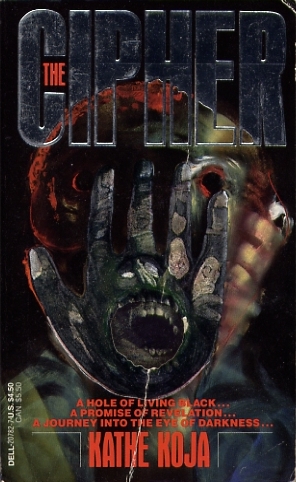
KK: Everything I write always begins with a character, and for Cipher it was Nicholas. How did you come about the idea of the Funhole? And the complex relationship between Nicholas and the Funhole – did it evolve as you wrote the novel, or was that always part of your vision for The Cipher?

This reminds me of one of the really intriguing elements of The Cipher – how the Funhole is both outside of Nicholas’ experience, but also maybe in some ways a manifestation of his unconscious, or at least a part of himself he never had access to before.

JP: I really like that idea of how moments that are “intensely strange” are difficult to process. And “psychedelic” in the sense of phantasmagoric, certainly – there’s a kind of brutally hyperreal feel to those moments of the intensely strange, the way a thing that is foreign to our experience is difficult to process, the eye shows it to the brain and the brain says, “Wait, what?!” Kathe Koja: I don’t have an art background, but visual art has always been a source of inspiration, enrichment, delight, in my life as well as my work. The novel has such a visual aspect, were you influenced by certain paintings or photographs, and do you have a background in the visual arts yourself?

Many of the descriptions are a heady blend of Gothicism and surrealism. I was thinking especially of how the Funhole transforms the insects, and the mouse, and Nicholas’ hand. James Pate: I was trying to describe The Cipher to a friend of mine recently without giving away too much of the story, and a phrase I found myself using was “psychedelic horror.” One of the elements I love about the novel is how the body horror is mixed up with an eerie type of wonder. I recently interviewed Koja through email about the novel.

A new print edition is forthcoming this September from Meerkat Press. Filled with sometimes beautiful, sometimes grotesque physical transformations, and laced through with meditations about nothingness and the unknown, The Cipher is an intense exploration of the outer edges of human experience. An unusual blend of body horror and cosmic horror, the story examines how a mysterious, physics-morphing hole found in an apartment building – called the Funhole by many of the characters in the novel – alters the lives of everyone that comes into contact with it, and especially the life of the narrator, Nicholas. Kathe Koja’s 1991 novel The Cipher is considered a classic of contemporary horror fiction.


 0 kommentar(er)
0 kommentar(er)
